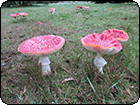Made My First Curry Tonight using
this recipe from allrecipes.com. I'm eating it as I type this. Initial verdict: much like its cook, this sauce is in need of some refinement. It's got kick to it -- I used three jalapeno peppers in place of the two serrano -- but it doesn't have the rich, multilayered taste of local restaurant curries. Any suggestions for improvement? (Other than the obvious -- reduce the chiles.)
 photo by splunge
photo by splunge
 photo by TheophileEscargot
photo by TheophileEscargot
 photo by Kronos_to_Earth
photo by Kronos_to_Earth
 photo by ethylene
photo by ethylene